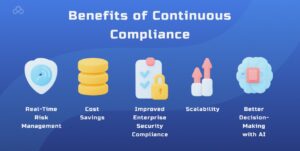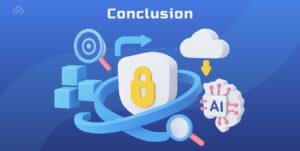Introduction
In today’s digital-first world, businesses are no longer only worried about innovation and growth. But also they face the constant challenge of protecting sensitive data to staying ahead of cyber threats, and meeting ever-evolving regulatory requirements. Enterprise security compliance has become one of the most top priorities for organizations across industries. Yet the older approach of conducting security audits once or twice a year no longer works. Why? Because threats do not wait for an audit. And this is where Continuous Compliance comes in.
Think of it as a new approach that helps enterprises to stay secure all the time instead of just getting the check list done during yearly audits. In this blog, we will explore why Continuous Compliance is the future of enterprise security, how it works, the role of automation and AI in making it more effective, and why your organization should not ignore it.
What Exactly is Continuous Compliance?
So, Continuous Compliance basically means monitoring and enforcing compliance standards every day, not just during a selected period of time. Instead of waiting for annual audits or external reviews, it enables enterprises to continuously track and fix issues in current time.
Imagine a bank that needs to follow strict security rules. And if it waits for a yearly audit, a small compliance gap could remain unnoticed for months which creates risks for customers and the institution. But with this, these issues are identified and fixed instantly, and reduce the risks amazingly.
There is no surprise that security leaders now believe that it is not just a nice-to-have but a must-have for advanced enterprise security compliance strategies.
Why Traditional Compliance is No Longer Enough
In the past, organizations were treating compliance like a checklist task. They used to prepare documents, set up temporary controls before audits, and then relaxed until the next round came. While this worked when cyber threats were less frequent, it is not effective in today’s environment where attacks happen so frequently.
Hackers of course will not wait for your compliance cycles. They look for weak points, and even the smallest bugs can be exploited. This reality makes it the logical choice. Instead of reacting to issues later, it allows enterprises to save them before they cause huge damage.
Continuous Compliance and Enterprise Security Compliance
Enterprise security compliance has grown vast with multiple frameworks like GDPR, HIPAA, PCI DSS, and ISO standards. Each comes with unique requirements, and managing them manually is a headache. It makes this easy by automating the process.
For example, if a healthcare provider must ensure HIPAA compliance, Continuous Compliance tools can automatically monitor whether access controls are working, whether patient data is encrypted, and whether staff follow security protocols. This automation minimizes the load on teams while improving accuracy.
In essence, it makes enterprise stronger and faster in security terms, and more reliable. It reduces the chances of human error while building a culture of security across the organization.
The Role of Automated Compliance Monitoring
One of the biggest strengths of Continuous Compliance is automated compliance monitoring. Instead of relying on manual checks, organizations can deploy tools that monitor systems, applications, and networks around the clock.
Let’s take an example. Suppose your enterprise must ensure that only authorized users access financial data. Automated compliance monitoring can track user activity in real time and flag unusual behavior, like someone downloading sensitive reports at odd hours. Without automation, this issue may go unnoticed until it is too late.
Automated compliance monitoring not only ensures compliance but also improves efficiency. Security teams spend less time chasing errors and more time on strategic tasks. Over time, this leads to stronger enterprise security compliance and reduced costs.
How AI is Transforming Continuous Compliance
Now let us talk about the exciting part- the role of AI in cybersecurity. Artificial Intelligence is already helping organizations to overcome cyber threats, and it plays an important role as well.
AI can analyze massive amounts of data from across enterprise systems and identify patterns that humans might miss. For example, if multiple small anomalies occur in different departments, AI can connect the dots and flag a potential compliance issue before it escalates.
The role of AI in cybersecurity also extends to predictive analysis. AI can forecast possible vulnerabilities based on historical data and suggest fixes proactively. This is especially important in Continuous Compliance, where the goal is to stay ahead of risks, not just respond to them.
When AI and automated compliance monitoring come together, they create a powerful shield for enterprises. They help reduce human error, accelerate decision-making, and strengthen enterprise security compliance like never before.
Benefits of Continuous Compliance

So why is it becoming the future of enterprise security? Let us look at the key benefits:
1. Real-Time Risk Management
With Continuous Compliance, organizations can spot risks the moment they occur. This minimizes the window of exposure and prevents breaches before they cause harm.
2. Cost Savings
Traditional audits are expensive. Fixing issues months later often costs more than addressing them immediately. Automated compliance monitoring reduces these costs significantly.
3. Improved Enterprise Security Compliance
It ensures that compliance requirements are met every day, not just during audits. This strengthens enterprise security compliance and boosts customer trust.
4. Scalability
As organizations grow, manual compliance becomes nearly impossible. It scales easily and adapts to new regulations and frameworks.
5. Better Decision-Making with AI
The role of AI in cybersecurity ensures that compliance data is not just collected but also analyzed intelligently. Leaders can make informed decisions based on accurate insights.
Real-World Examples of Continuous Compliance
Let’s bring this closer to reality with a few examples:
– Financial Institutions: Banks must comply with stringent regulations like PCI DSS. It helps them monitor every transaction, ensuring that sensitive payment data is always protected.
– Healthcare Providers: Hospitals must follow HIPAA rules. It ensures that patient data is encrypted, access is restricted, and staff activities are continuously monitored.
– Technology Companies: With GDPR and other data privacy laws, tech firms use automated compliance monitoring to manage vast amounts of customer data securely.
These examples show that it is not limited to one sector. It is a necessity across industries where data and security are critical.
Challenges in Adopting Continuous Compliance
Of course, no solution comes without challenges. Adopting Continuous Compliance can feel overwhelming for some organizations. Common challenges include:
– Integration Issues: Enterprises often use multiple tools. Integrating them for automated compliance monitoring may require planning.
– Skill Gaps: Teams need training to work effectively with AI-driven compliance systems.
– Initial Costs: The setup may feel costly, but the long-term savings outweigh the investment.
The good news is that with the right strategy and tools, these challenges can be addressed effectively.
The Future of Enterprise Security Compliance
Looking ahead, Continuous Compliance will be the standard, not the exception. Organizations that adopt it early will have a competitive edge, as customers and regulators increasingly demand transparency and security.
The combination of Continuous Compliance, automated compliance monitoring, and the role of AI in cybersecurity will transform enterprise security compliance into a dynamic and proactive system. Instead of reacting to threats, enterprises will anticipate and prevent them.
Conclusion

The world of enterprise security is evolving rapidly, and organizations can no longer afford to rely on outdated compliance models. So,it is the future because it ensures that enterprises stay compliant every day, not just during audits.
By embracing automated compliance monitoring and leveraging the role of AI in cybersecurity, businesses can stay one step ahead of cybercriminals while meeting all regulatory requirements. More importantly, it builds trust with customers, partners, and regulators by showing that security is a continuous priority.
If you want to make your enterprise truly future-ready, adopting Continuous Compliance is no longer a choice but it is a necessity.
FAQs on Continuous Compliance
1. What is Continuous Compliance in enterprise security?
It is the practice of monitoring and enforcing compliance requirements in real time rather than relying on periodic audits.
2. Why is Continuous Compliance better than traditional compliance?
Unlike traditional audits,it provides ongoing protection, reducing risks and keeping enterprise security compliance active every day.
3. How does automated compliance monitoring help enterprises?
Automated compliance monitoring tracks systems continuously, flags issues instantly, and reduces the workload on security teams.
4.What is the role of AI in cybersecurity for compliance?
The role of AI in cybersecurity includes detecting patterns, predicting vulnerabilities, and strengthening it with intelligent insights.
5. Which industries benefit most from Continuous Compliance?
Industries like finance, healthcare, and technology benefit greatly since they manage sensitive data and must meet strict compliance standards.
6. Is adopting Continuous Compliance costly?
While initial setup may require investment, it reduces long-term costs by preventing breaches and lowering audit preparation expenses.
7. How does Continuous Compliance improve customer trust?
By ensuring enterprise security compliance 24/7, organizations build trust with customers, showing that their data and privacy are always protected.
Do you like to read more educational content? Read our blogs at Cloudastra Technologies or contact us for business enquiry at Cloudastra Contact Us.